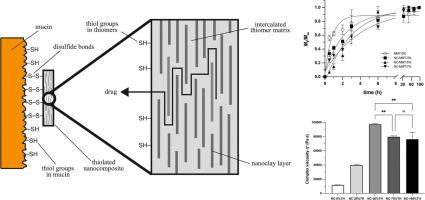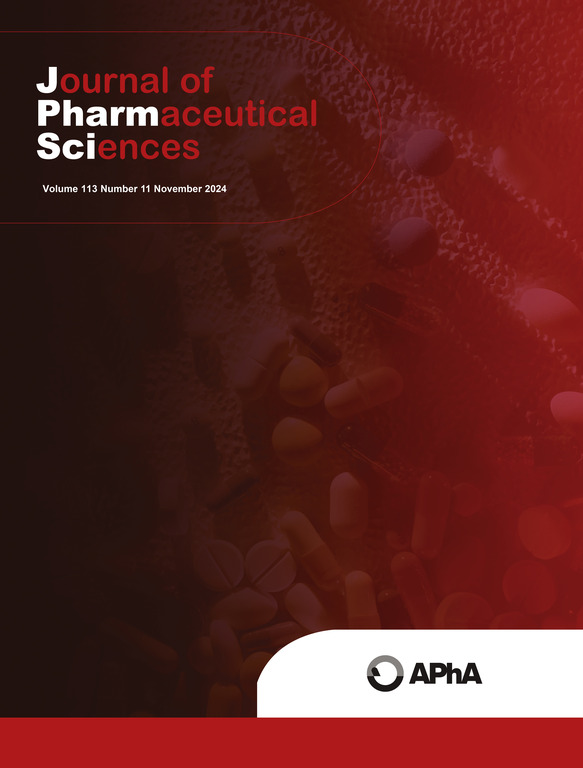Synthesis of thiomer/nanoclay nanocomposites as a potential drug carrier: Evaluation of mucoadhesive and controlled release properties
IF 3.7
3区 医学
Q2 CHEMISTRY, MEDICINAL
引用次数: 0
Abstract
Novel thiomer/nanoclay nanocomposites based on a thiomer and montmorillonite (MMT) were prepared in order to obtain a mucoadhesive material with controlled release properties for its potential use as drug carrier. The thiomer was synthesized by immobilization of L-cysteine in alginate mediated by carbodiimide reaction and further characterized by FT-IR and Ellman's reaction. Nanocomposites with growing concentrations of thiomer and MMT were prepared and analyzed by XRD, TGA and TEM. Rheological behavior of nanocomposite in contact with mucin and intestinal mucus were studied as in vitro and in situ mucoadhesion approach, showing until ∼10-fold increasing in the complex viscosity and ∼27-fold in elastic modulus when the amount of thiomer is increased. Higuchi and Korsmeyer-Peppas kinetic models were evaluated in order to study the release of deltamethrin from nanocomposite films. Release profiles showed a retard in the migration of the drug influenced by the amount of MMT (P < 0.05). Diffusion coefficient (D) showed a significant decrease (P < 0.0001) when concentration of MMT is increased reaching D = 4.18 × 10–7 m2 h–1, which resulted ∼7-fold lower in comparison with formulation without MMT. This hybrid nanocomposite can be projected as a potential mucoadhesive drug carrier with controlled release properties.

作为潜在药物载体的硫代物/纳米黏土纳米复合材料的合成:黏附性和控释性能评估
为了获得一种具有控释特性的粘液粘附材料并将其用作潜在的药物载体,本研究制备了基于硫代物和蒙脱石(MMT)的新型硫代物/纳米粘土纳米复合材料。硫代物是通过碳二亚胺反应将 L-半胱氨酸固定在海藻酸盐中合成的,并通过傅立叶变换红外光谱和埃尔曼反应对其进行了进一步表征。制备了硫代物和 MMT 浓度不断增加的纳米复合材料,并通过 XRD、TGA 和 TEM 进行了分析。研究了纳米复合材料与粘蛋白和肠粘液接触时的流变学行为,结果表明,当硫单体的用量增加时,复合粘度增加 10 倍,弹性模量增加 27 倍。为了研究溴氰菊酯从纳米复合薄膜中的释放,对 Higuchi 和 Korsmeyer-Peppas 动力学模型进行了评估。释放曲线显示,药物的迁移速度受 MMT 含量的影响而减慢(P < 0.05)。当 MMT 的浓度增加时,扩散系数(D)显著降低(P < 0.0001),达到 D = 4.18 × 10-7 m2 h-1,与不含 MMT 的配方相比降低了 7 倍。这种混合纳米复合材料有望成为一种具有控释特性的粘液粘附药物载体。
本文章由计算机程序翻译,如有差异,请以英文原文为准。
求助全文
约1分钟内获得全文
求助全文
来源期刊
CiteScore
7.30
自引率
13.20%
发文量
367
审稿时长
33 days
期刊介绍:
The Journal of Pharmaceutical Sciences will publish original research papers, original research notes, invited topical reviews (including Minireviews), and editorial commentary and news. The area of focus shall be concepts in basic pharmaceutical science and such topics as chemical processing of pharmaceuticals, including crystallization, lyophilization, chemical stability of drugs, pharmacokinetics, biopharmaceutics, pharmacodynamics, pro-drug developments, metabolic disposition of bioactive agents, dosage form design, protein-peptide chemistry and biotechnology specifically as these relate to pharmaceutical technology, and targeted drug delivery.

 求助内容:
求助内容: 应助结果提醒方式:
应助结果提醒方式:


